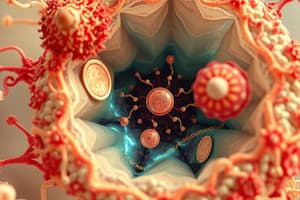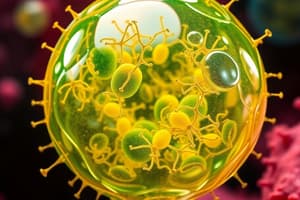Podcast
Questions and Answers
At what temperature do thermophiles typically grow best?
At what temperature do thermophiles typically grow best?
- 80°C - 110°C
- 40°C - 50°C
- 15°C - 25°C
- 50°C - 60°C (correct)
Which of the following statements about Archaea is correct?
Which of the following statements about Archaea is correct?
- They lack cell walls.
- They include some extremophiles. (correct)
- They have well-defined nuclei.
- They are universally larger than bacteria.
Which is NOT a characteristic of the kingdom Fungi?
Which is NOT a characteristic of the kingdom Fungi?
- Cell walls made of chitin
- Non-motile
- Decomposers
- Photosynthetic (correct)
What type of reproduction is primarily associated with Plantae?
What type of reproduction is primarily associated with Plantae?
Which group does NOT fall under the classification of Plantae?
Which group does NOT fall under the classification of Plantae?
Which type of organism is known for its ability to thrive in acidic environments?
Which type of organism is known for its ability to thrive in acidic environments?
What is a distinguishing feature of Protista?
What is a distinguishing feature of Protista?
Why are fungi considered important in ecosystems?
Why are fungi considered important in ecosystems?
What is the function of enzymes in biochemical reactions?
What is the function of enzymes in biochemical reactions?
What can cause proteins to become denatured and non-functional?
What can cause proteins to become denatured and non-functional?
Which component is NOT part of a nucleotide?
Which component is NOT part of a nucleotide?
Which type of cell contains a cell wall made of cellulose?
Which type of cell contains a cell wall made of cellulose?
Which nucleotides are components of RNA?
Which nucleotides are components of RNA?
What is the primary role of adenosine triphosphate (ATP) in cells?
What is the primary role of adenosine triphosphate (ATP) in cells?
What is the structure of DNA?
What is the structure of DNA?
What type of bonds connect the nitrogenous bases in DNA?
What type of bonds connect the nitrogenous bases in DNA?
What is the primary role of cells in living organisms?
What is the primary role of cells in living organisms?
How can one differentiate between an organ and a tissue?
How can one differentiate between an organ and a tissue?
Which of these is NOT considered a basic building block of life?
Which of these is NOT considered a basic building block of life?
What distinguishes cells from one another?
What distinguishes cells from one another?
What is an example of a tissue?
What is an example of a tissue?
What represents the smallest common denominator of life?
What represents the smallest common denominator of life?
Which of the following is an organ?
Which of the following is an organ?
What is a key distinction between active and passive transport in cells?
What is a key distinction between active and passive transport in cells?
What type of organisms are classified as Animalia?
What type of organisms are classified as Animalia?
Which of the following elements constitute 96.5% of all atoms in an organism?
Which of the following elements constitute 96.5% of all atoms in an organism?
What type of bond is formed by the unequal sharing of electrons?
What type of bond is formed by the unequal sharing of electrons?
What defines a prokaryotic cell?
What defines a prokaryotic cell?
Which statement is true about ionic bonds?
Which statement is true about ionic bonds?
Which of the following best defines multicellular organisms?
Which of the following best defines multicellular organisms?
What type of interaction is a hydrogen bond?
What type of interaction is a hydrogen bond?
Which of the following is NOT true regarding eukaryotic cells?
Which of the following is NOT true regarding eukaryotic cells?
What is the primary role of microtubules in the context of motor protein movement?
What is the primary role of microtubules in the context of motor protein movement?
Which of the following functions is NOT associated with lysosomes?
Which of the following functions is NOT associated with lysosomes?
Which statement about intermediate filaments is accurate?
Which statement about intermediate filaments is accurate?
How does Taxol (paclitaxel) affect microtubules?
How does Taxol (paclitaxel) affect microtubules?
Which of the following statements about peroxisomes is true?
Which of the following statements about peroxisomes is true?
What is the function of colchicine in relation to microtubules?
What is the function of colchicine in relation to microtubules?
What characteristic distinguishes kinesins from dyneins?
What characteristic distinguishes kinesins from dyneins?
What type of diseases could be caused by defective intermediate filaments?
What type of diseases could be caused by defective intermediate filaments?
Flashcards are hidden until you start studying
Study Notes
Cells: The Basic Units of Life
- Cells are the fundamental building blocks of all living organisms.
- They are the smallest unit capable of independent life.
- Cells can be distinguished by size, shape, structure, and function.
Types of Organisms
- Prokaryotic: Lack a nucleus, single-celled, small size, examples include Bacteria and Archaea.
- Eukaryotic: Have a nucleus, can be single-celled or multicellular, larger in size, examples include Protista, Fungi, Plantae, and Animalia.
The Chemical Components of Cells
- Essential Elements: C, H, O, and N make up the majority of an organism's atoms.
- Electrolytes: K, Na, Cl, Mg, P, Ca, Fe, and I are important for various cellular functions.
- Covalent Bonds: Electrons are shared equally or unequally between atoms.
- Non-polar: Electrons are shared equally (e.g., C-C, C-H bonds).
- Polar: Electrons are shared unequally due to differences in electronegativity.
- Ionic Bonds: Atoms gain or lose electrons, forming charged ions that attract each other.
- Hydrogen Bonds: Weak interactions between a hydrogen atom and a highly electronegative atom (like oxygen or nitrogen).
Essential Molecules
- Proteins: Large, complex molecules made up of amino acids.
- Functions: Regulation, structure, signaling, transport, catalysis, motor proteins.
- Enzymes: Biological catalysts that speed up chemical reactions.
- Specificity: Enzymes catalyze specific reactions.
- Reversible reactions: Enzymes can facilitate both forward and reverse reactions.
- Coenzymes: Some enzymes require a coenzyme or cofactor for activity.
- Factors affecting enzyme activity: Temperature, pH, enzyme concentration, substrate concentration.
- Nucleotides: Monomers of nucleic acids (DNA and RNA).
- Components: Nitrogenous base, sugar, phosphate groups.
- RNA: A, G, C, U, mostly single-stranded.
- DNA: A, G, C, T, double-stranded helix.
- ATP: Adenosine triphosphate is the primary energy carrier in cells.
Eukaryotic Cell Structure
- Cell Wall: Found in plants, fungi, and bacteria, provides protection, structure, and support.
- Composed of: Cellulose (plants), chitin (fungi), peptidoglycan (bacteria).
- Cell Membrane: Encloses the cell and regulates what enters and exits.
- Composed of: Phospholipid bilayer with embedded proteins.
- Cytoplasm: The gel-like substance within the cell that houses the organelles.
- Nucleus: Contains the cell's genetic material (DNA).
- Ribosomes: Sites of protein synthesis.
- Endoplasmic Reticulum (ER): Network of membranes involved in protein synthesis and lipid metabolism.
- Rough ER: Has ribosomes attached, involved in protein synthesis.
- Smooth ER: Lacks ribosomes, involved in lipid synthesis and detoxification.
- Golgi Apparatus: Processes and packages proteins and lipids for secretion or delivery to other organelles.
- Lysosomes: Contain digestive enzymes that break down cellular waste products and ingested materials.
- Peroxisomes: Small vesicles involved in fatty acid and alcohol metabolism, cholesterol synthesis, and amino acid digestion.
- Mitochondria: Powerhouses of the cell, responsible for cellular respiration and energy production.
- Chloroplasts: Found in plant cells, responsible for photosynthesis.
- Vacuoles: Storage compartments for water, nutrients, and waste products.
- Cilia and Flagella: Hair-like or whip-like structures for movement.
- Cytoskeleton: Network of protein fibers that provides structural support and enables cell movement.
- Microtubules: Hollow tubes made of tubulin, involved in cell shape, organelle movement, and cell division.
- Functions: Mitotic spindle formation, cilia and flagella structure, viral movement.
- Microfilaments: Solid rods made of actin, involved in muscle contraction, cell shape, and movement.
- Functions: Muscle contraction, cytoplasmic streaming.
- Intermediate Filaments: Resilient networks of protein fibers, providing structural support and resisting mechanical stress.
- Functions: Structural support, resistance to mechanical stress.
- Microtubules: Hollow tubes made of tubulin, involved in cell shape, organelle movement, and cell division.
Studying That Suits You
Use AI to generate personalized quizzes and flashcards to suit your learning preferences.




